1lumen selects and reviews products personally. We may earn affiliate commissions through our links, which help support our testing.
Convoy M21D review
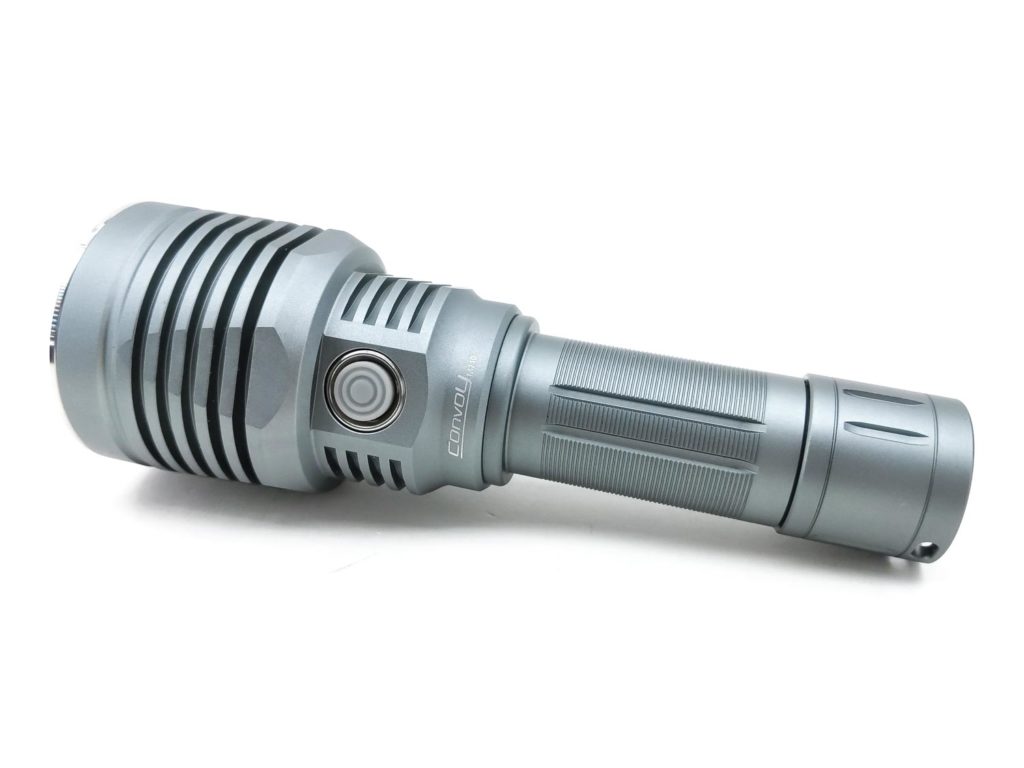
Convoy M21D specifications
| Brand/model | Convoy M21D |
|---|---|
| LED | CREE XHP70.2 |
| Lumens | 4,300 lm |
| Beam intensity | N/A |
| Battery config. | 1*21700 |
| Material | Aluminum |
| Modes | 5 or ramping |
| Blinkies | Strobe |
| Reflector | Smooth |
| Waterproof | IPX8 |
| Review date | August 2021 |
Introduction:
“If it ain’t broke, don’t fix it.” Sound familiar? Yeah, I’ve heard it a million times, too. But I’ve never paid it any attention. On the contrary, my parents almost encouraged me to do quite the opposite. From a very young age, my father would bring home watches, radio, locks, and other inexpensive perfectly-fine objects for me to tear apart so I could see what made them tick. It was that encouragement that helped set me up for a lifetime of tinkering (sometimes to the chagrin of my wife!).
I feel like Simon is alike in that manner. Sometimes he takes a flashlight design that is perfectly fine and just can’t leave it alone. Take, for example, the Convoy M21C-U that I recently reviewed and fell in love with. I gave it 5 stars and I stand behind that rating. So what does Simon do with a good thing? He messes with it!
Package quality.
If you’ve read any of my recent reviews of Convoy flashlights, you know what’s coming. There’s a nice, sturdy, brown paper-board box. And inside that box is…
- Convoy M21D
Yup, that’s it! Simon isn’t messing around here. ou ordered a flashlight, and that’s exactly what you got. I’m not really going to complain, as 99% of the time I look at that stuff (spare o-rings, a so-so lanyard, etc) and toss it into my bin of “stuff” and never think about it again. So I’m more or less fine with this. Well, ok, a manual might not have hurt. But I guess that’s what we have the internet (and this review!) for, right?
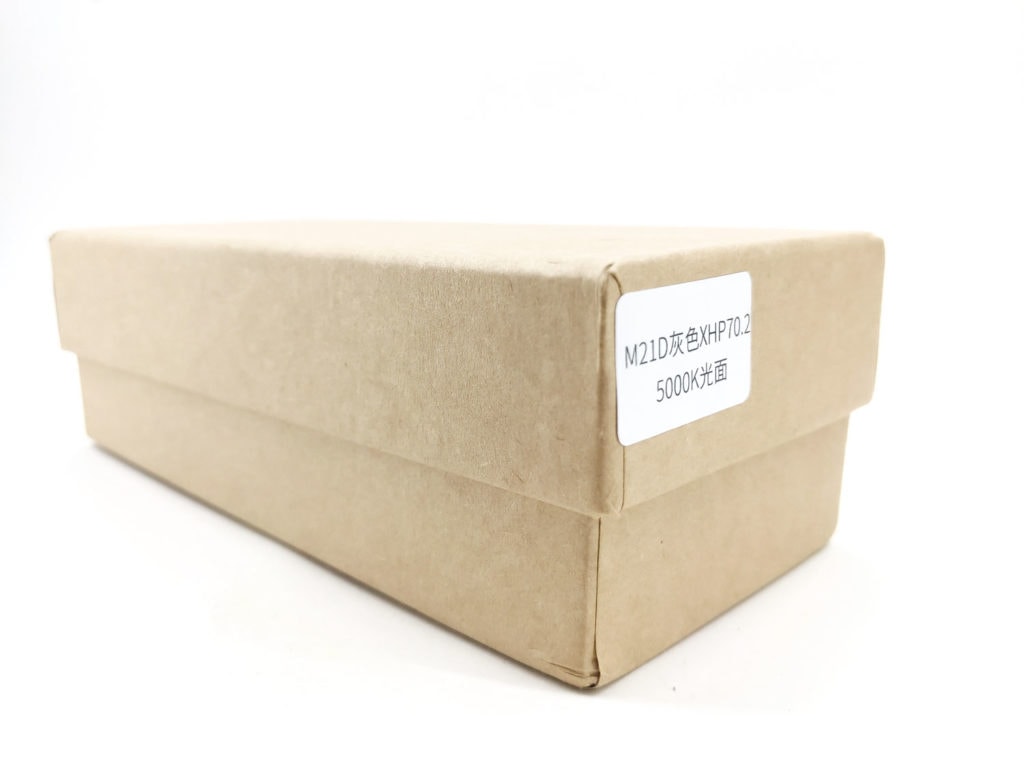
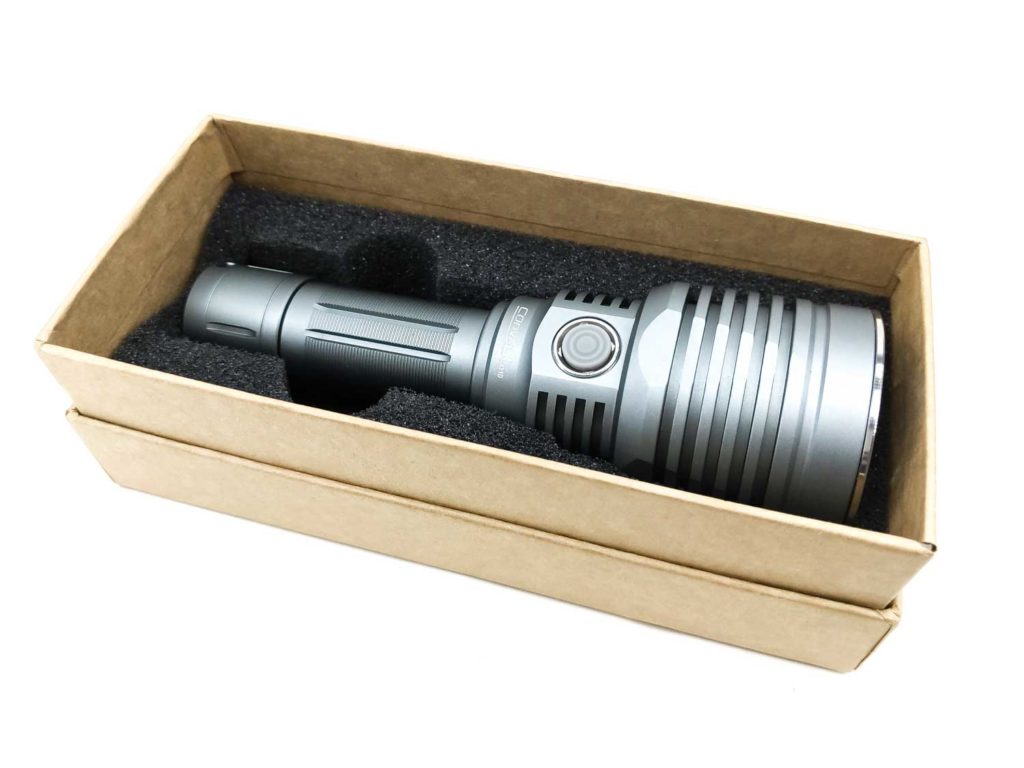
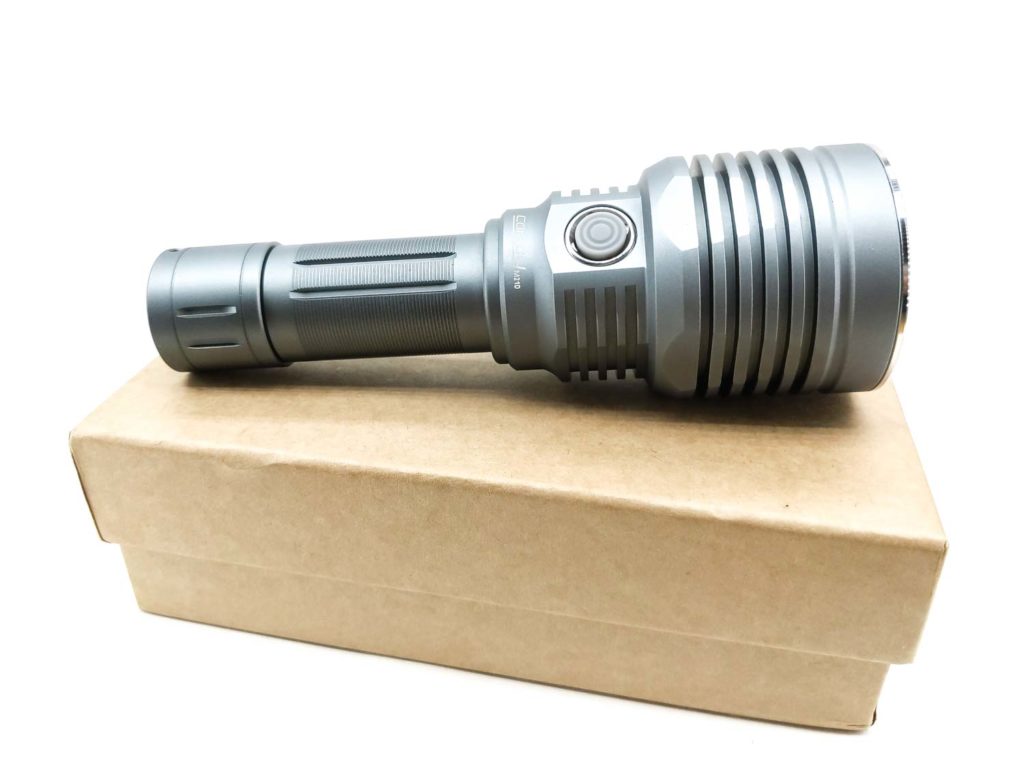
Flashlight in use
The Convoy M21D feels extremely comfortable in hand. It feels really well balanced, and the placement of the side e-switch matches up nicely with how the tube is grasped. Something about the dimensions just feels right for a powerful flashlight.
The head has flat areas on five sides that help visually taper the head as well as provide anti-roll features. The tailcap is quite flat, it can tailstand easily. That tailcap also has holes that a lanyard, should you choose to provide one, can be threaded through.
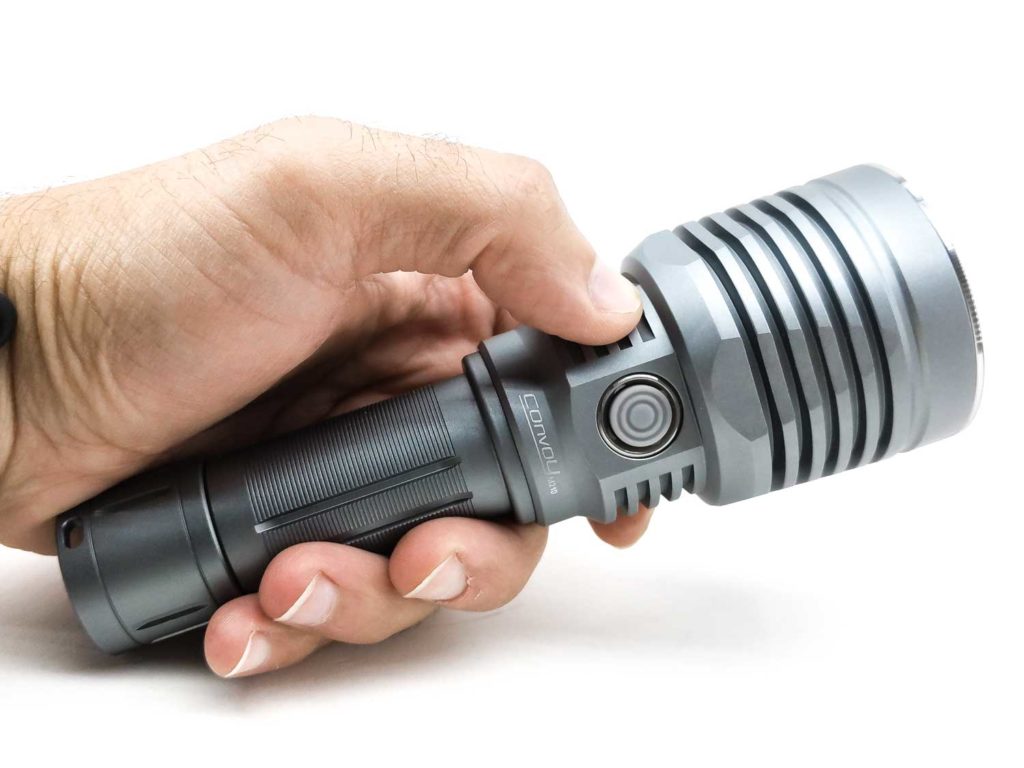
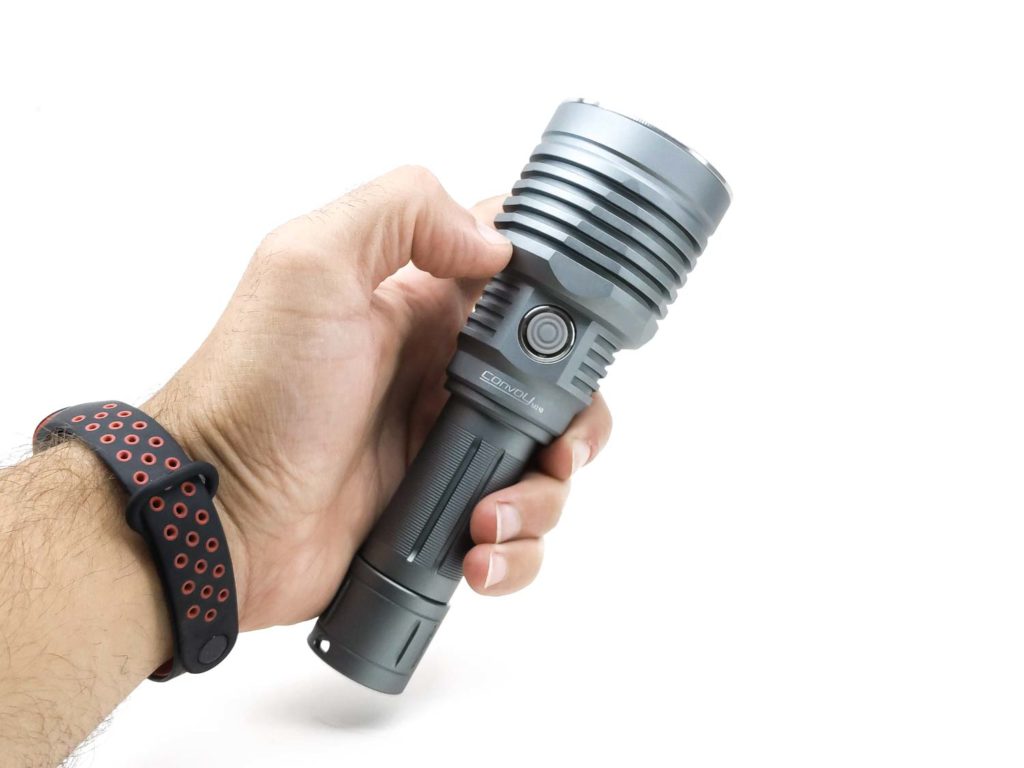
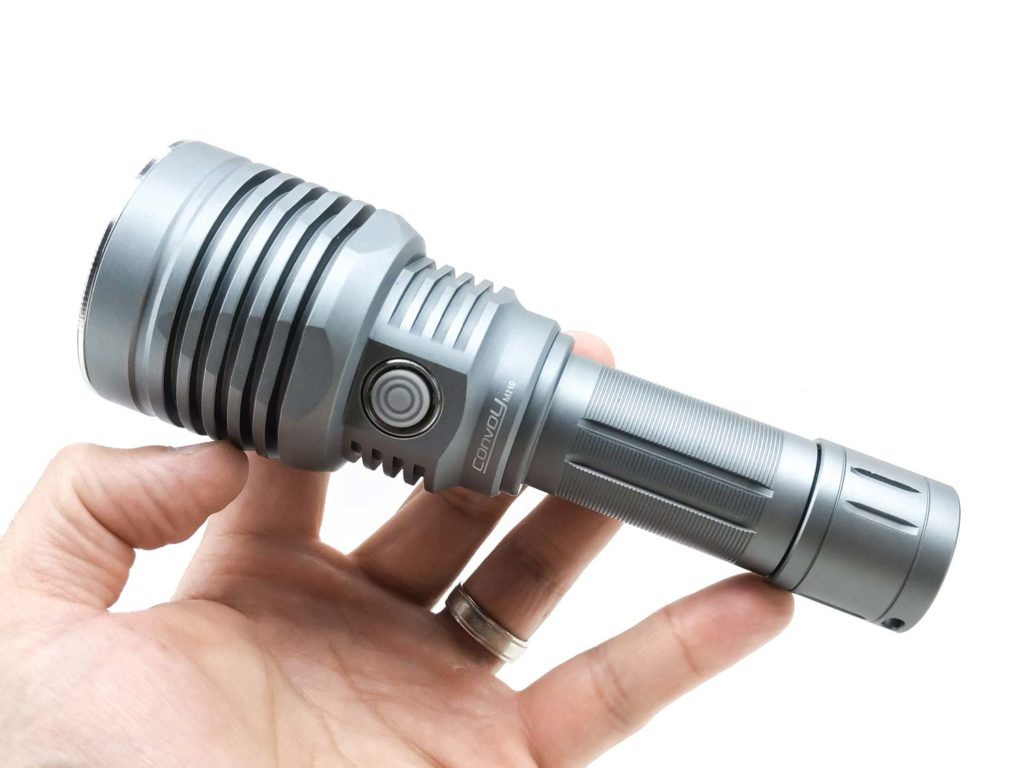
Build Quality, and Warranty
As requested, my sample came in “gray” colored anodizing. I figured this would be the same as my “titanium” M21C-U, but nope. It’s definitely lighter, but still very nice. I feel like I’ve mentioned this a couple of times lately, but I’m kind of tired of black flashlights. I feel like we’re starting to see a few more colors show up, be they Desert Tan, Olive Drab, Cyan, etc. And this flawless gray anodizing provides a good visual distinction without being too flashy.
The head is adorned with a smooth stainless steel bezel. Like most other Convoys, the M21D has solid square-cut threads that are smooth; anodized on the tail end and non-anodized towards the head. There isn’t really knurling, per se, but the tail is cut with some rings and channels that provide a decent amount of grip. The side switch button is surrounded by a stainless ring that pairs nicely with that stainless bezel. Unlike the M21C-U which has a black button, the M21D has a gray button.
I’ve never seen anything official regarding a Convoy warranty. From everything I’ve heard, though, Simon is glad to help if anything goes wrong (like sending out replacement parts, etc) without any problems.
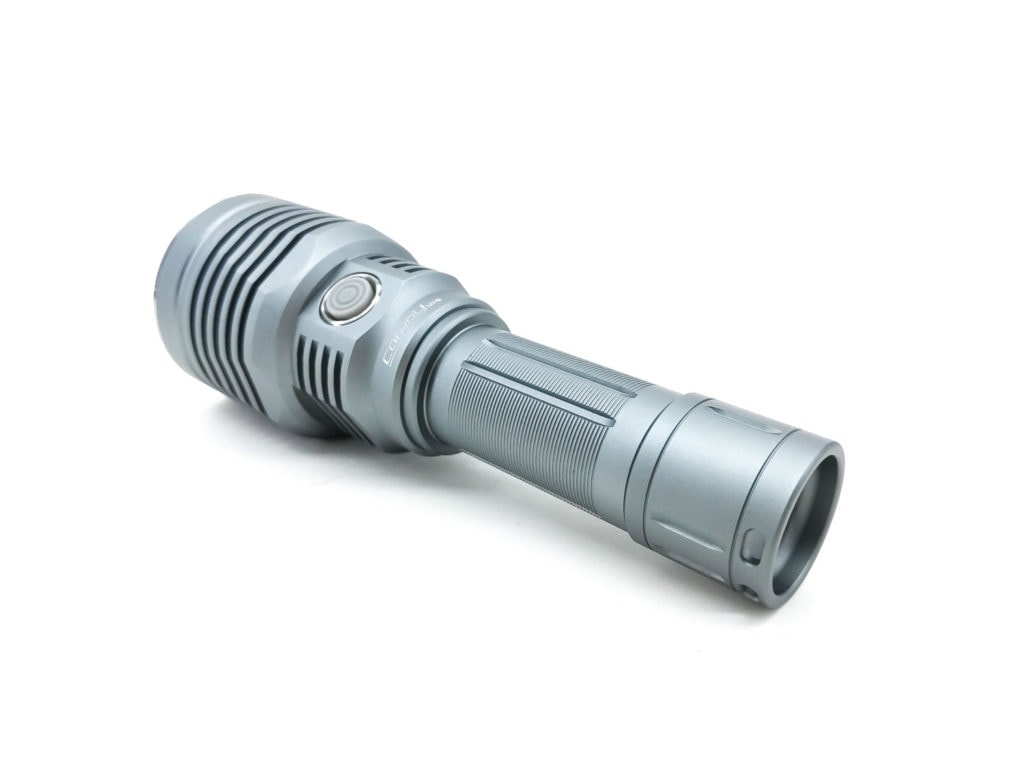
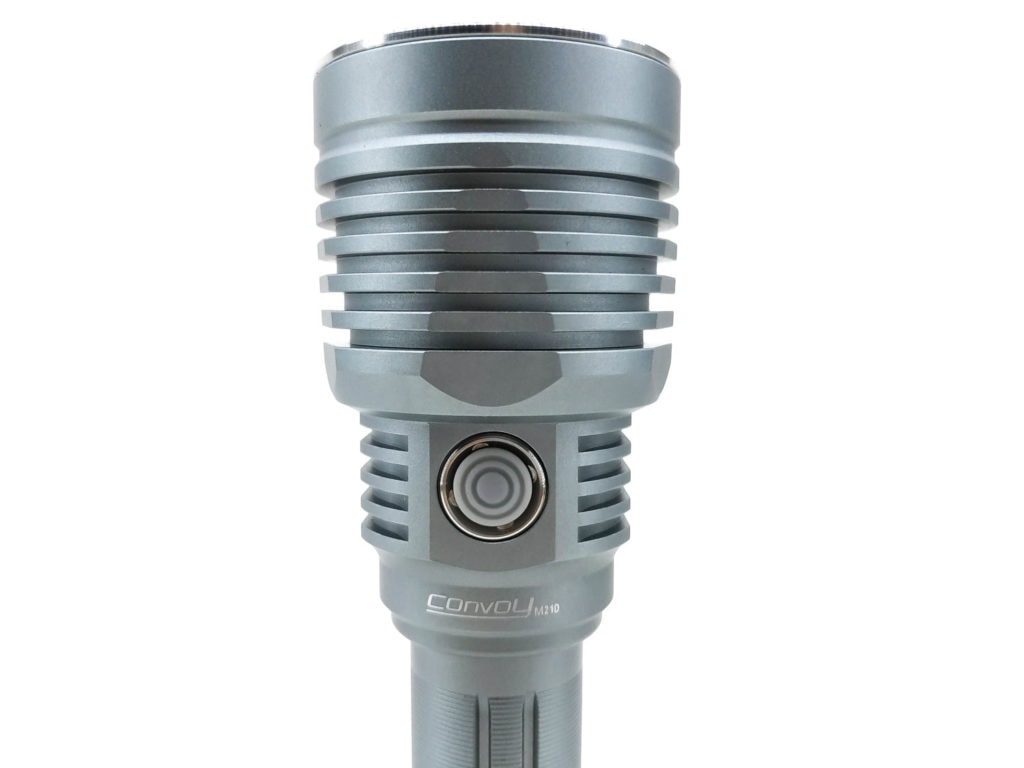
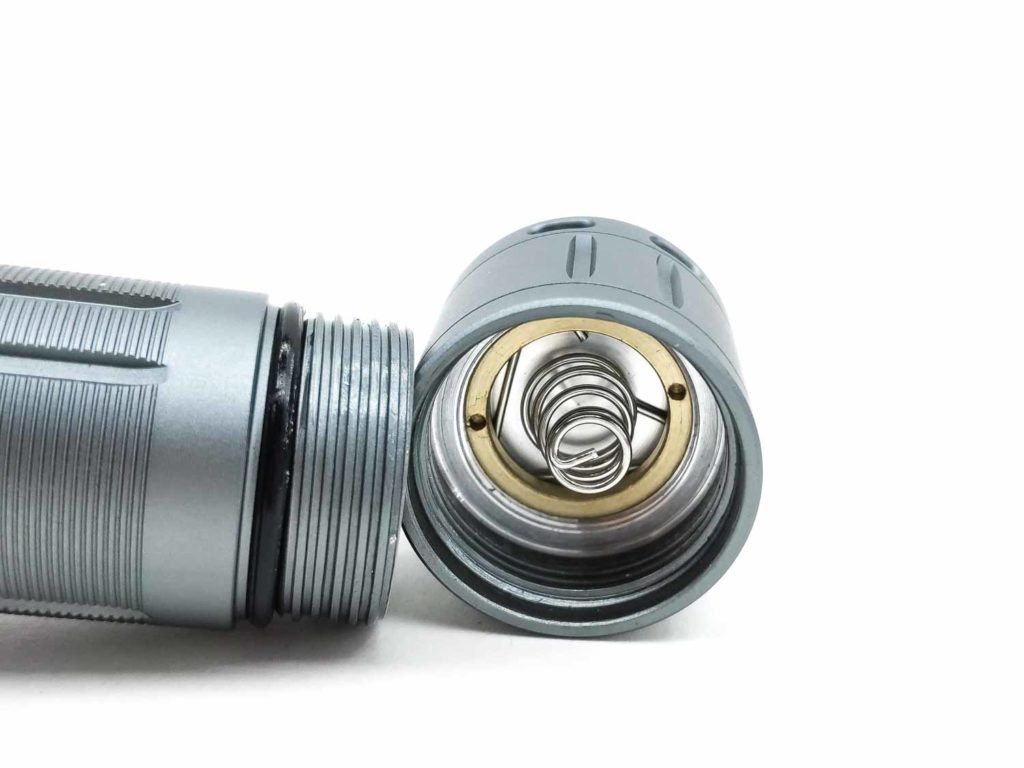
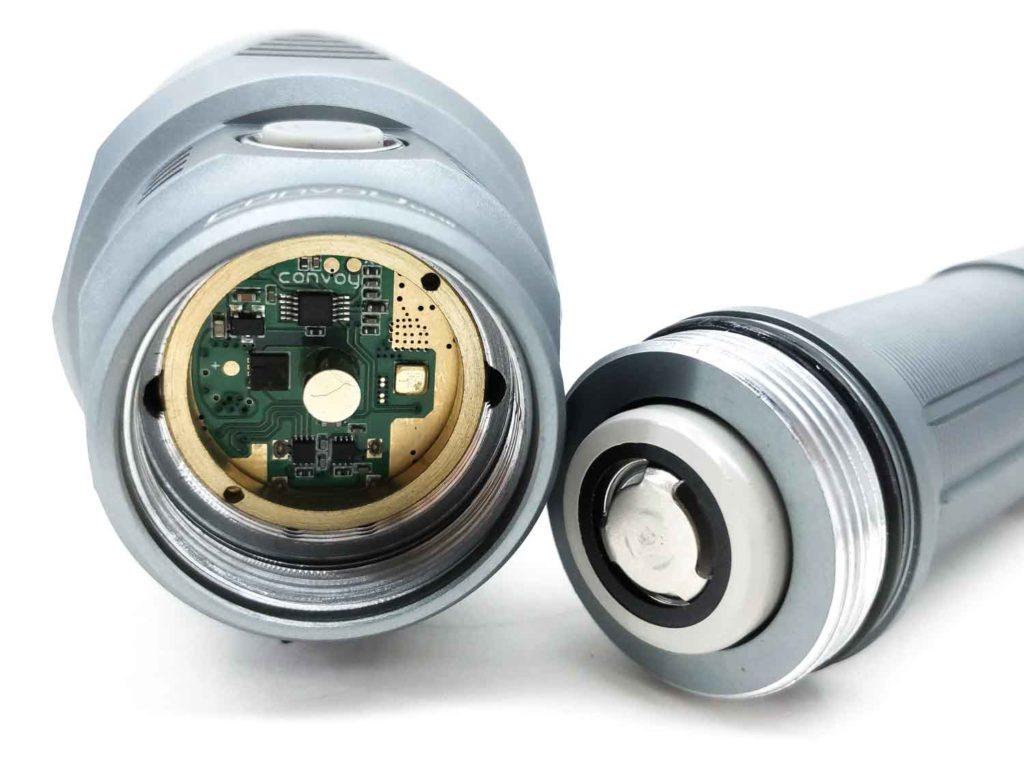
LED, Lens, Bezel, and Reflector
The Convoy M21D comes with a Cree XHP70.2 LED. In typical Convoy fashion, it comes with several CCT options including 6500K, 5000K, 4000K, and 3000K. My particular sample is 5000K, my favored temperature.
The powerful emitter is nestled in a smooth reflector. I usually don’t fuss over reflector styles that much, but many would call into question using a smooth reflector with an XHP LED because of the potential for tint shift and “donut holes” (a dark spot in the middle of the beam). I’m pleased to say that I don’t actually notice any donut hole effect, part of that is likely due to this being the XHP70.2 version which has the dies closer and completely coated in a layer of phosphor. There is certainly a small bit of tint shift when white wall hunting, but I did not notice its presence when using the M21D outdoors. To be honest, I’ve seen much worse. There is a single, faint ring outside of the main spill area because of the stainless steel bezel. .
I’m a fan of the stainless bezel though – it gives the light a nice, distinguished look so I’ll gladly overlook that ring. Convoy also now gives the option of ordering the M21D with a “crumpled” (orange peel) reflector. That could help minimize some of the rings and tint shift if you’re picky about that kind of thing.
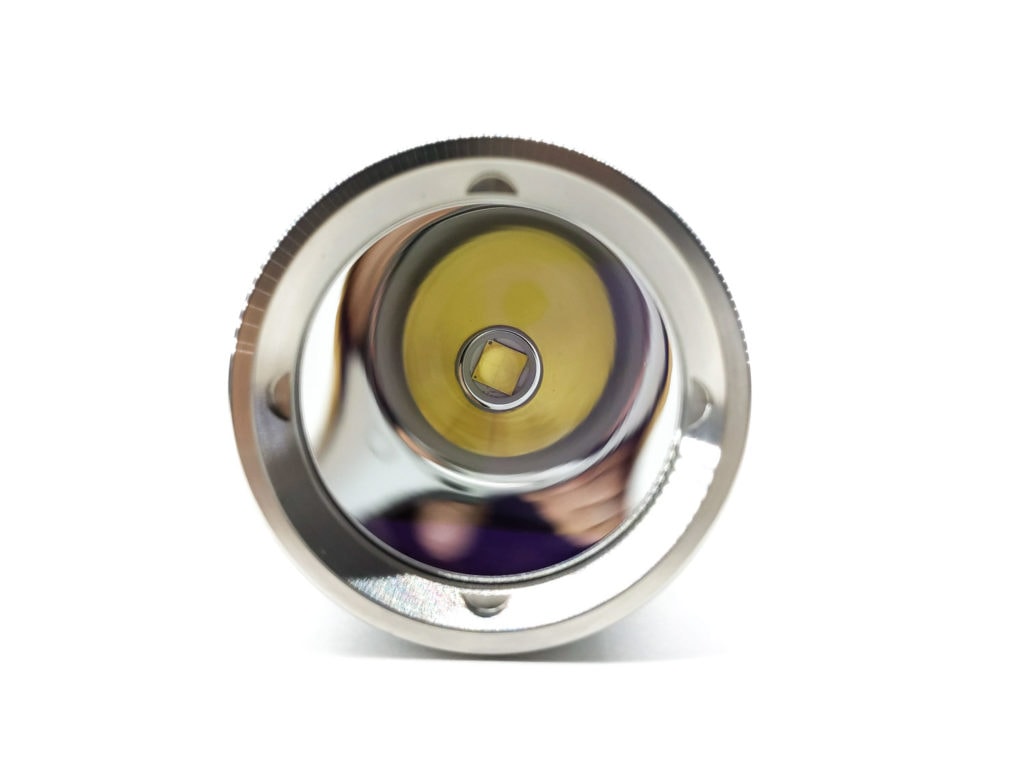
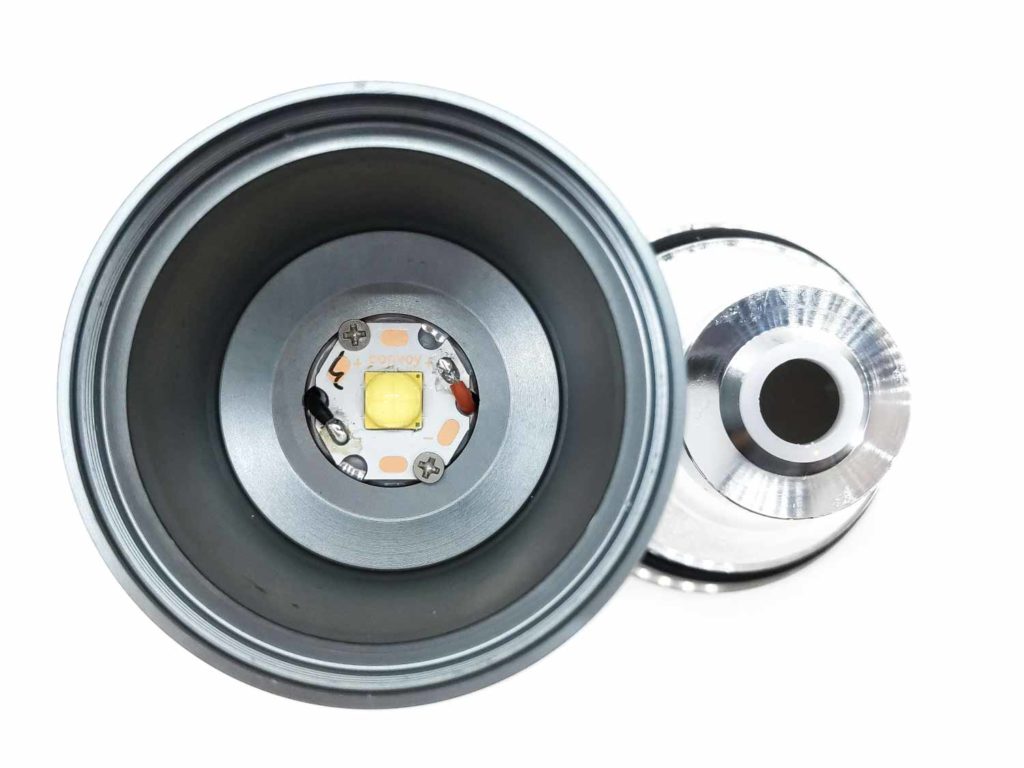
Dimensions and size comparison
- Length: 161.5 mm / 6.4 inches
- Head diameter: 55 mm / 2.2 inches
- Body diameter: 28 mm / 1.1 inches
Weight:
- Without cells: 289 grams / 10.2 oz
- With cells: 358 grams / 12.6 oz
Flashlight size comparison with its competition
Convoy near-twins, left to right: Convoy M21D, Convoy M21C-U
Mid-to-large Convoys, left to right: Convoy M21D, Convoy L7, Convoy C8+
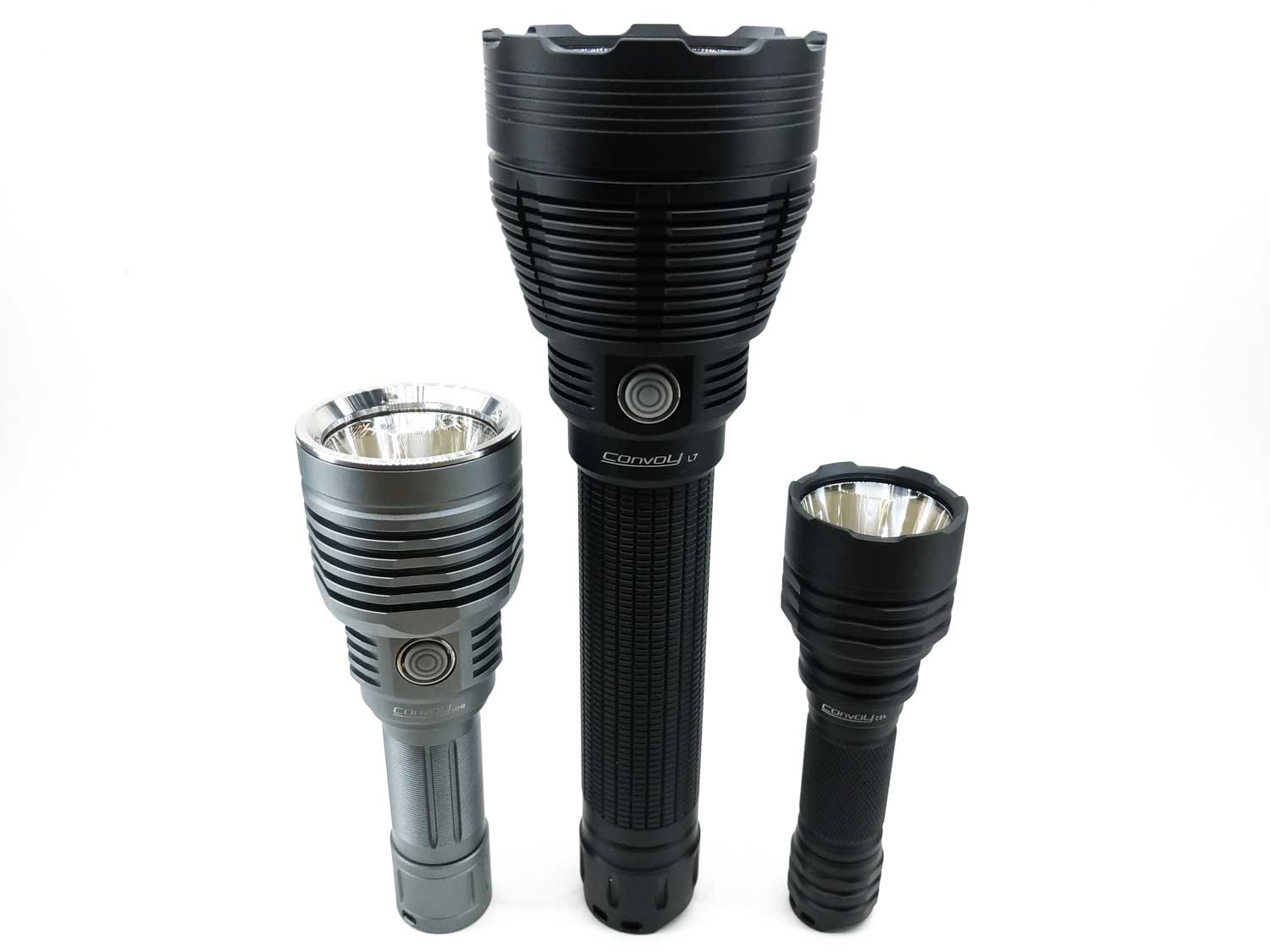
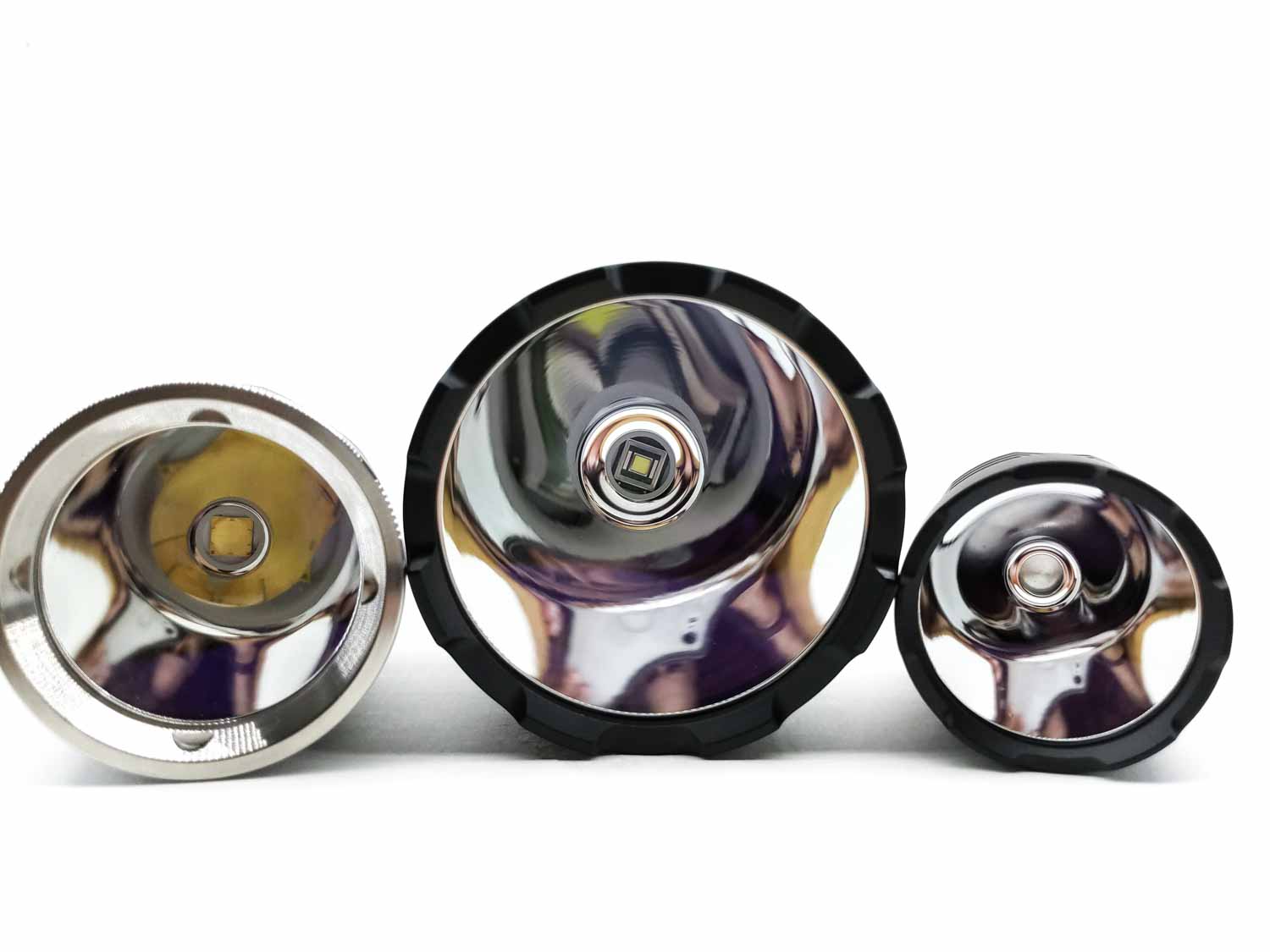
Driver & User Interface:
The Convoy M21D uses a driver held in place by a retaining ring. The tail has a fairly stout looking spring; the driver contact is a tall brass post. The UI gives you the option of ramping or stepped modes. Overall, the firmware is relatively full-featured.
Available modes: Ramping or 4 modes (1% – 10% – 30% – 100%) (plus “moonlight”)
From OFF:
- Press and Hold: turn on in moonlight (0.2% brightness)
- Single click: turn on in last used mode (or ramp position)
- Double click: turbo
- Triple click: strobe
- 4x click: tactical mode (4x click again to exit)
- 5x click: voltage readout (in volts pause tenths)
- 6x click: switch between ramping and stepped modes
- 10x click: lock (10x click again to unlock)
From ON:
- Press and Hold: ramp up
- Single click: turn off
- Double click: turbo
- Triple click: strobe
Mode memory:
- Yes, mode memory is present
Shortcuts:
- To Low: hold from off
- To Turbo: double click
- To Strobe: triple click
Low voltage warning:
- Once the M21D hits the low voltage threshold, it blinks every 30 seconds or so
Strobe/blinkies
- Strobe mode is present and accessed via a triple click whether the light is on or off
Lock-out mode:
- Lock-out is enabled (or disabled) with 10 clicks from off. It will be confirmed with a double blink. If you press the button while the light is locked out, it will blink at you. There is no momentary action.
PWM
- No PWM was detected
Additional info on the UI:
- While I really appreciate that the UI offers a ramping option, like other Convoys that have offered ramping, it spends much too little time in the low end of the ramp and too much time in the high end of the ramp. It’s almost like the ramp is linear instead of exponential or logarithmic.
Batteries & Charging
For my testing of the M21D, I’ve used a Samsung 50G. It’s a great fit for this light, but physically and electrically speaking. Other unprotected cells such as the Molicel P42A or Lishen LR2710SD work great as well with room to spare. I tried my longest 21700, a protected Acebeam cell with built-in charging – it did not fit properly, it was a bit too long.
If you’ve been saying to yourself, “all of this sounds the same, what makes the M21D different?” Well, you’ve finally arrived. The Convoy M21D (unlike the M21C-U) is a great rechargeable LED flashlight, and includes built-in USB-C charging! It seems to be well implemented, too. I can confirm that it supports USB-PD charging (that is, Power Delivery over USB-C to USB-C). Convoy claims a charge rate of 2 amps, and that seems right. I observed 9.1 watts, which lines up. It was able to charge a depleted 5000 mAh cell in 3 hours and 37 minutes with a terminating voltage of 4.18 volts – very nice! You want to know how to make a great light even better? Add a great USB-C charging circuit.
One minor quibble worth noting… during some of the runtime tests, I noticed the USB port cover would end up popped out a bit. I’m guessing that’s because of expansion due to heat. It didn’t seem like much of an issue, but would be something to watch out for.

Performance
For current measurements, an ANENG AN8008 multimeter and UNI-T UT210E clamp meter were used. Lux was measured by a UNI-T UT383 BT at 10 meters. Lumens were measured in a homemade lumen tube using a TSL2591 sensor, calibrated with a Maukka calibration light. Temperature was monitored with a MLX90614 IR temperature sensor. A Samsung 50G was used for testing.
Lumen measurements (for each mode)
| Mode | Amps at start | Specs | 10min | 30 sec | start |
|---|---|---|---|---|---|
| Moon | 36 mA | . | . | . | 20 |
| Low | 60 mA | . | . | . | 40 |
| Med | 680 mA | . | 482 | 487 | 488 |
| High | 1.9 A | . | 1329 | 1357 | 1374 |
| Turbo | 7.6 A | 4300 | 1579 | 3635 lm | 3846 |
Parasitic drain:
- 47 uA, nice and low
Runtime graph

The Turbo runtime test started out at 3846 lumens, just a little shy of Convoy’s claim of 4300 lumens. Then again, I am testing the 5000K version. I’m sure the 6500K LED would measure a bit higher. The output sagged a little bit during the first 2 minutes, then it began to ramp down a bit more intentionally. It stopped dropping at 13 minutes when it hit 1391 lumens. The output stayed steady until 1 hour 42 minutes when the low voltage warning kicked in. The output dropped to 37 lumens and blinked every 30 seconds or so. The M21D continued in that fashion for 4 more hours, finally shutting itself off at 5 hours and 54 minutes. The battery was at 2.95 volts. The peak temperature was a fair 53.7°C.
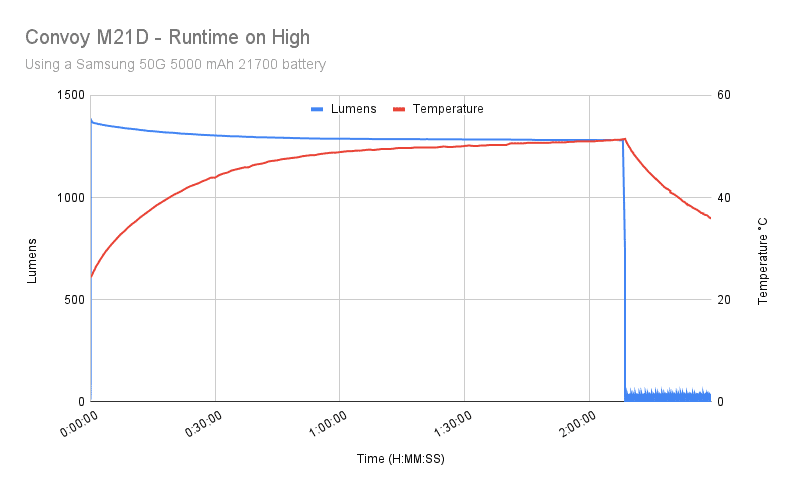
The High runtime test was uneventful. It started out at 1374 lumens and was fairly consistent, just dropping slowly throughout the run. The low voltage warning kicked in at 2 hours and 8 minutes. The temperature topped out at 51.4°C.
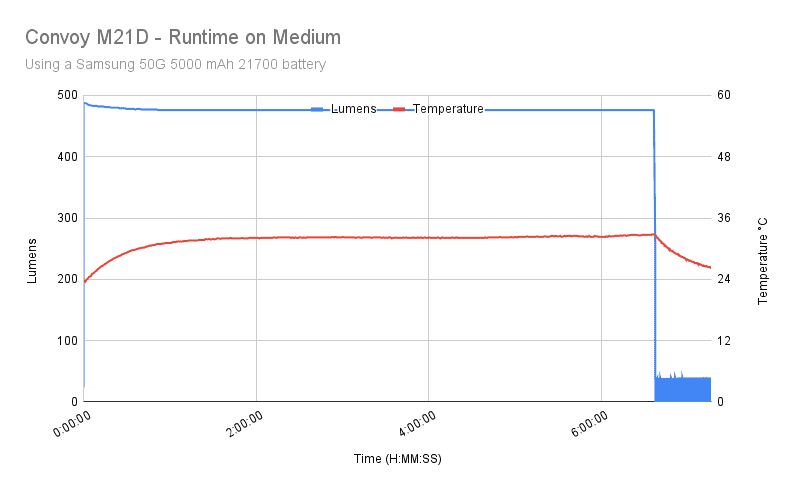
If the High test was uneventful, the Medium test was downright boring if I may say so. It started out at 488 lumens and stayed right around there for the length of the test. Low voltage warning kicked in at 6 hours and 36 minutes with a max temperature of 32.8°C.
Throw numbers:
For the throw measurements, I tested the M21D at 10 meters using my UNI-T UT383 BT and a calibration factor based on the Maukka calibration light.
| Mode | Specs | Candela measured | Meters | Yards |
|---|---|---|---|---|
| Medium | . | 5,300 cd | 146 | 160 |
| High | . | 15,100 cd | 246 | 269 |
| Turbo | N/A | 43,700 cd | 418 | 457 |
Beamshots
The farm shed in these beamshots is 100 meters (109 yards) away. Pictures were taken with my Pixel 3 using ƒ/1.8, ⅕ second exposure time, ISO200, and 5000K white balance.
- Convoy M21D
- Convoy L7
- Convoy 3x21A
- Mateminco MT90Mini SBT90.2
- Fenix LR50R
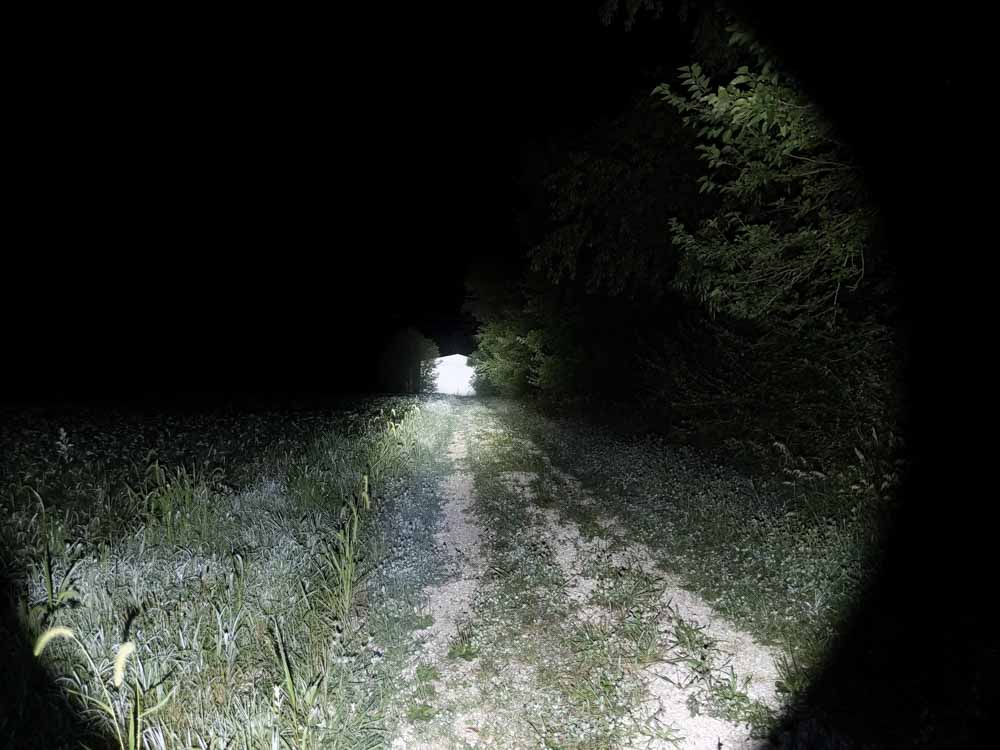


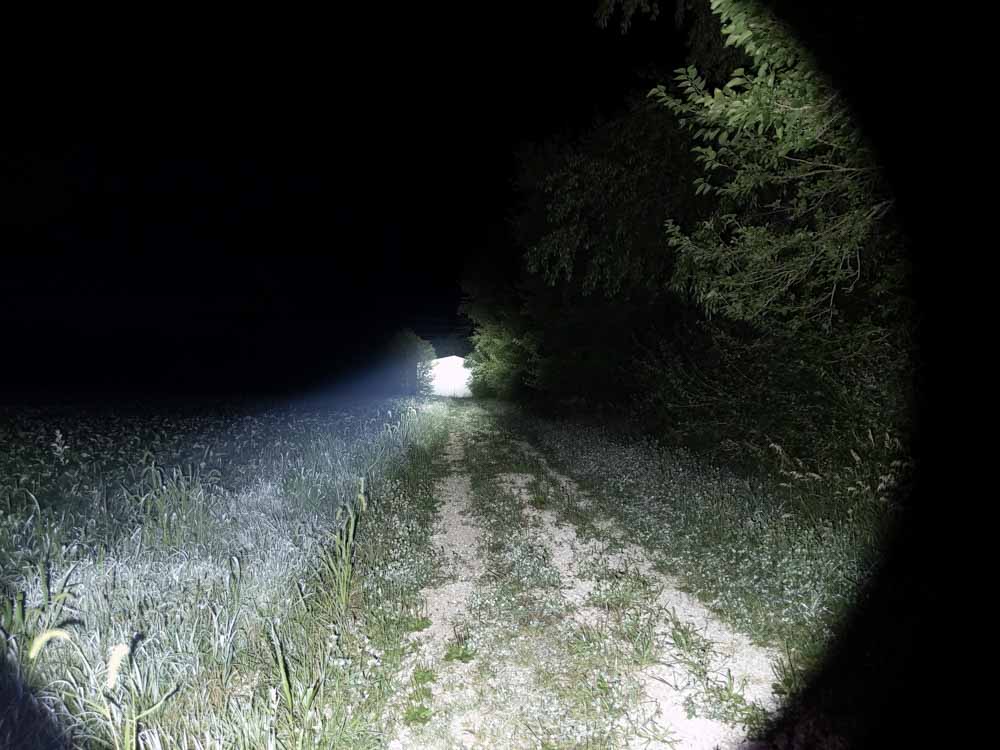

Disclaimer: This flashlight was sent to me for review at no cost by Convoy. I have not been paid to review, nor have I been holding back on problems or defects.
Final Verdict
Pros
- Powerful / bright
- Good balance of flood and throw
- Well regulated driver
- Built-in 2A USB-C charging!
- Temperature regulation
- Solidly built
- Good looks
- Ramping and Stepped UI options
Cons
- Ramp speed (linear ramp?)
- Tint shift – the optional “crumpled” (OP) reflector might have been beneficial
Explanation on star ratings:
1: Avoid: my phone flashlight would be a better choice – 2: Poor: significant defect or issues, much better options available at the same price – 3: Average: some defects or issues – 4: Good: recommended (minor issues) – 5: Great: highly recommended

5 stars: ★★★★★
See, sometimes you should mess with a good thing! With the M21D, Simon took one of my favorite Convoy lights (the M21C-U) and made it even better by adding built-in USB-C (including PD) charging. That’s a win. The result is just such a great all-around flashlight that performs well. And it’s got strikingly good looks to boot.
Convoy M21D for sale
1lumen selects and reviews products personally. We may earn affiliate commissions through our links, which help support our testing.